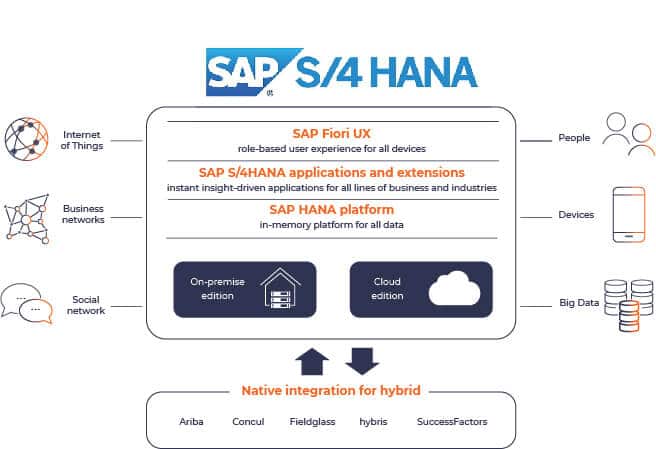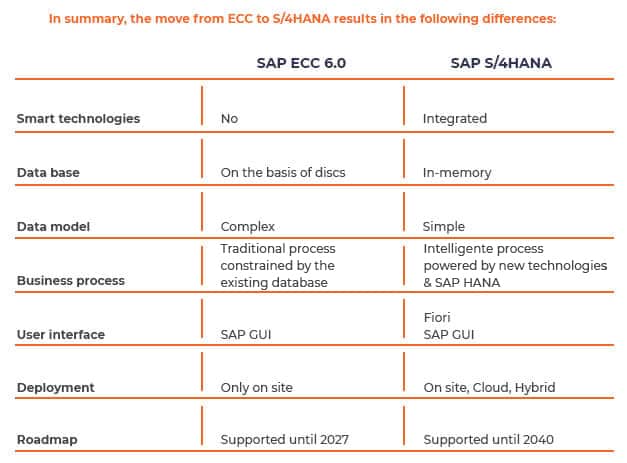Home - Why choose SAP S/4HANA ?

Why should you use SAP S/4HANA?
Minh-Thu Dotu
Access to smart and emerging technologies
Differentiating yourself from your competitors by leveraging the latest technologies has become inevitable. SAP S/4HANA is the ERP that enables you to achieve your digital transformation goals.
Optimizing your service chain by using automation, artificial intelligence, IoT, machine learning, or blockchain is a priority. You reduce the risk of error from human intervention and allow your staff to focus on higher value tasks. From procurement to billing to product or service delivery, companies that want to stand out have a card to play with emerging technologies.
Technology leap with SAP HANA
SAP HANA is a database that stores data in RAM for faster processing. SAP HANA is a leader in the Big Data market. It allows the processing of huge volumes of data, in real time. With this type of technology, there is no more batch processing, the data model is simplified and the decision process is accelerated.
It was specifically designed to be the foundation for intelligent technologies and automation processes. Installing SAP HANA is preparing for emerging technologies.
SAP HANA is much more than a database. It provides advanced search, analysis and data integration capabilities for all types of data. It also functions as an application server and helps companies build intelligent applications based on real-time data, in-memory computing and machine learning technology.
SAP S/4HANA is the new suite designed to run on SAP HANA and no other database. This means users can access data from anywhere in real time for planning, execution, prediction and simulation.
Cloud offering
SAP S/4HANA brings you additional flexibility compared to ECC or most non-SAP ERP: available in a public or private cloud, on-premise, or in a hybrid environment.
Cloud offerings open the door to new approaches in managing your ICT department. You have the opportunity to outsource all or part of your IT services. You can benefit from specific expertise in the areas of security, data storage, …
The SAP S/4HANA Cloud editions, Public and Private, allow you to focus on your core business, while software hosting and maintenance are outsourced. Applications, application servers, database, operating systems and hardware are supported and secured by SAP.
What is the best option for your company? In a hybrid environment, what is the best mix of on-premise and public/private cloud for you?
In the article SAP S/4HANA: Cloud, On-premise or Hybrid? we go into more detail about the advantages and disadvantages of each solution.
Real-time data volume and predictive analytics
We are no longer limited in terms of the volume of data stored with SAP S/4HANA. In addition, your staff, customers and suppliers have access to real-time data, which has a significant impact on improving your business. You have a real-time view of inventory (raw materials, consumables and products), location and activities of your teams.
Thanks to the predictive power of analytics, you are able to optimize your decisions and anticipate actions that will benefit your business.
The ability to analyze large volumes of data in real time allows you to increase the commercial value of your business.
Fiori and access to other SAP products
Fiori is the new SAP S/4HANA user interface. It replaces the SAP GUI.
Modern, customizable and intuitive, Fiori is an intelligent assistant that takes advantage of artificial intelligence and machine learning. Switching to Fiori is recommended for the ergonomic, graphical, practical and aesthetic improvements it brings.
With SAP S/4HANA, the SAP GUI remains available. However, some new functionalities are only available on Fiori, such as FSCM-BAM (bank account management module).
With SAP S/4HANA, you get an integrated environment with access to data from several SAP products such as Ariba, Concur, Fieldglass, Hybris or SuccessFactors. With Fiori, you have access via a single interface.

2027 As deadline
The table below summarizes the main differences between SAP ECC6 and SAP S/4HANA.

The gap between the functionalities of SAP S/4HANA and ECC6, in a context of digital transition, makes ECC6 obsolete. Companies get a real competitive advantage by switching to SAP S/4HANA. For this reason, SAP will no longer support and maintain ECC from 2027.
Since the migration to SAP S/4HANA is inevitable, it is best to consider it as soon as possible. Waiting until the last minute and paying in the meantime for developments that meet the specific needs of the business will only add to the bill. Indeed, these needs could be integrated into a global and coherent analysis taking into account the potential offered by SAP S/4HANA.
An implementation or a migration to SAP S/4HANA implies a major technical overhaul.
As an SAP reseller, do not hesitate to contact us to evaluate the time and duration of such a project based on an analysis of your business, your constraints and your objectives.
If you decide to take the plunge and move to SAP S/4HANA, the first questions you’ll ask are related to the type of deployment.
Three scenarios are possible: :
- Greenfield or New Implementation means redesigning your processes and applying standard functionality and industry best practices.
- Brownfield or System Conversion is the fastest deployment because your existing configuration, customizations and historical data are preserved.
- Hybrid Deployment combines the concept of Greenfield and Brownfield in the configuration and customization and even retains some historical system data.
The choice between a Greenfield, Brownfield or Hybrid deployment depends on several parameters that we analyze in detail in the article SAP S/4HANA migration: which approach suits your company best?
The choice between IaaS, PaaS and SaaS should also be included in your approach to moving to SAP S/4HANA.
Copyright S4IC - 2021


